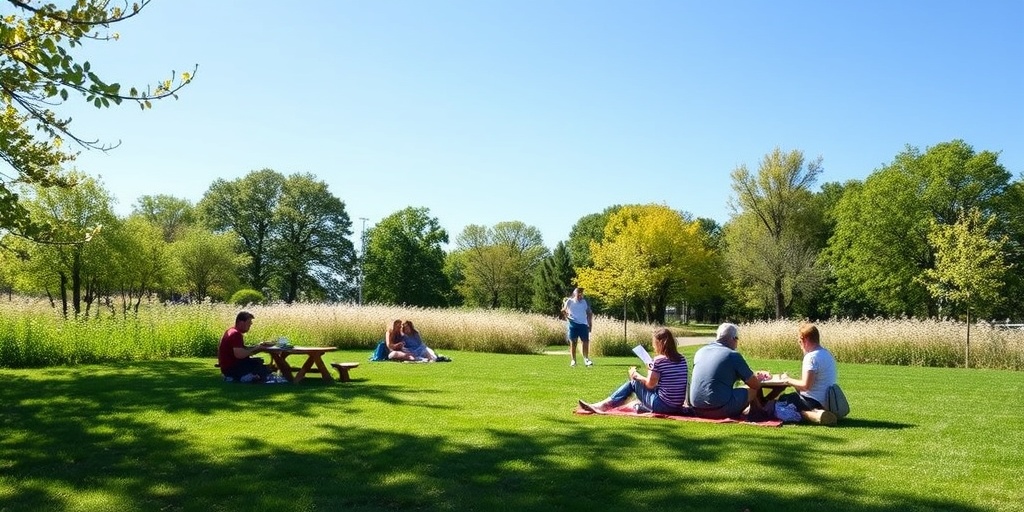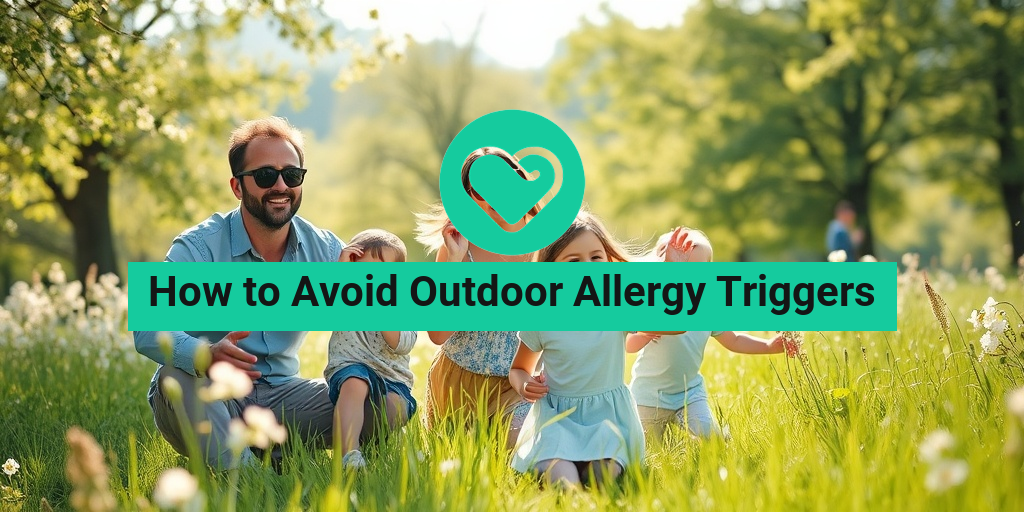Understanding Outdoor Allergies
Outdoor allergies, often referred to as seasonal allergies or hay fever, are a common issue for many individuals, especially during certain times of the year. These allergies occur when the immune system overreacts to allergens present in the environment, leading to a range of uncomfortable symptoms. Understanding the nature of outdoor allergies is crucial for effective management and prevention.
What Causes Outdoor Allergies?
Outdoor allergies are primarily caused by exposure to various allergens found in nature. The most common culprits include:
- Pollen: Trees, grasses, and weeds release pollen into the air, which can trigger allergic reactions.
- Mold Spores: Mold thrives in damp environments and releases spores that can become airborne.
- Dust and Debris: Outdoor activities can stir up dust and debris, which may contain allergens.
When these allergens enter the body, the immune system mistakenly identifies them as harmful, leading to the release of histamines and other chemicals. This response results in symptoms such as sneezing, runny nose, itchy eyes, and even asthma attacks in sensitive individuals.
Who is Affected by Outdoor Allergies?
Outdoor allergies can affect anyone, but certain factors may increase the likelihood of developing these allergies:
- Family History: A family history of allergies or asthma can increase your risk.
- Age: Allergies often develop in childhood or early adulthood.
- Geographic Location: Some regions have higher pollen counts or mold growth, making residents more susceptible.
Understanding your personal risk factors can help you take proactive measures to manage your symptoms effectively.
Common Outdoor Allergy Triggers
Identifying common outdoor allergy triggers is essential for anyone looking to minimize their exposure and alleviate symptoms. Here are some of the most prevalent triggers:
Pollen
Pollen is one of the leading causes of outdoor allergies. Different plants release pollen at various times of the year:
- Tree Pollen: Typically peaks in early spring.
- Grass Pollen: Common in late spring and early summer.
- Weed Pollen: Often prevalent in late summer and fall.
Monitoring local pollen forecasts can help you plan outdoor activities and reduce exposure during peak times.
Mold Spores
Mold spores can be a significant trigger for outdoor allergies, especially in humid conditions. Mold thrives in damp areas, such as:
- Decaying leaves
- Wet soil
- Shady, moist areas
To minimize exposure, avoid outdoor activities after heavy rainfall or during high humidity days.
Air Pollution
While not a traditional allergen, air pollution can exacerbate allergy symptoms. Pollutants can irritate the respiratory system, making it more sensitive to allergens. Staying indoors on days with high pollution levels can help reduce symptoms.
Insect Stings
For some individuals, insect stings from bees, wasps, or hornets can trigger allergic reactions. If you know you are allergic to insect stings, take precautions when spending time outdoors, such as wearing protective clothing and avoiding areas where insects are likely to nest.
Tips to Avoid Outdoor Allergy Triggers
Now that you understand the common triggers, here are some practical tips on how to avoid outdoor allergy triggers:
- Check Pollen Counts: Use apps or websites to monitor pollen levels in your area.
- Limit Outdoor Activities: Stay indoors during peak pollen times, typically early morning and on windy days.
- Wear Protective Gear: Sunglasses and masks can help reduce exposure to pollen and other allergens.
- Shower After Outdoor Activities: Rinse off pollen and other allergens that may cling to your skin and hair.
- Consult a Healthcare Professional: If your symptoms persist, consider seeking advice from a healthcare provider or allergist.
For more evidence-based health answers and personalized advice, consider visiting Yesil Health AI. They provide valuable resources to help you manage your health effectively.
By understanding outdoor allergies and their triggers, you can take proactive steps to minimize your exposure and enjoy the great outdoors with greater comfort. 🌼🌳

Seasonal Allergies Explained
Seasonal allergies, often referred to as hay fever or allergic rhinitis, are a common condition that affects millions of people worldwide. These allergies occur when the immune system overreacts to allergens present in the environment, particularly during certain times of the year. Understanding the triggers and mechanisms behind seasonal allergies is crucial for effective management.
What Causes Seasonal Allergies?
Seasonal allergies are primarily caused by pollen from trees, grasses, and weeds. As these plants release pollen into the air, individuals who are sensitive to these particles may experience allergic reactions. The most common sources of pollen include:
- Tree Pollen: Typically peaks in spring, with trees like oak, birch, and cedar being major contributors.
- Grass Pollen: Common in late spring and early summer, with grasses such as Bermuda and Timothy being prevalent.
- Weed Pollen: Often peaks in late summer and fall, with ragweed being one of the most notorious offenders.
In addition to pollen, other outdoor allergens such as mold spores and dust mites can also trigger symptoms, especially in damp or humid conditions. Understanding these triggers can help individuals take proactive measures to minimize exposure.
How Seasonal Allergies Develop
When a person with seasonal allergies comes into contact with pollen or other allergens, their immune system mistakenly identifies these harmless substances as threats. This triggers the release of histamines and other chemicals, leading to the characteristic symptoms of allergies. The severity of these reactions can vary based on individual sensitivity and the amount of allergen exposure.
Symptoms of Outdoor Allergies
Recognizing the symptoms of outdoor allergies is essential for effective management. Common symptoms include:
- Runny or Stuffy Nose: Often accompanied by sneezing, this is one of the most prevalent symptoms of outdoor allergies.
- Itchy Eyes, Nose, or Throat: Allergic reactions can cause significant discomfort, leading to persistent itching.
- Coughing: This can occur due to post-nasal drip or throat irritation from allergens.
- Fatigue: Allergies can lead to tiredness, especially if symptoms disrupt sleep.
- Headaches: Sinus pressure from nasal congestion can result in headaches.
In some cases, outdoor allergies can exacerbate existing conditions such as asthma, leading to more severe respiratory symptoms. It’s important for individuals with asthma to monitor their allergy symptoms closely, as they may require adjustments to their asthma management plan during allergy season.
When to Seek Medical Attention
While many people can manage their outdoor allergy symptoms with over-the-counter medications, there are times when professional help is necessary. If you experience any of the following, consider consulting a healthcare provider:
- Severe Symptoms: If your symptoms are debilitating or do not improve with standard treatments.
- Worsening Asthma: If you notice an increase in asthma symptoms or difficulty breathing.
- Persistent Symptoms: If your symptoms last longer than the typical allergy season or are unresponsive to treatment.
Understanding the symptoms and triggers of outdoor allergies is the first step in managing them effectively. By being aware of what causes your allergies and how they manifest, you can take proactive steps to minimize your exposure and improve your quality of life during allergy season. 🌼

Preventive Measures to Take
Outdoor allergies can be a significant nuisance, especially during peak seasons when pollen counts soar. However, there are several preventive measures you can take to minimize your exposure to allergens and enjoy the great outdoors without the sneezing and itching. Here are some effective strategies:
1. Monitor Pollen Counts
Stay informed about the pollen levels in your area by checking local weather reports or using apps dedicated to allergy forecasts. Websites like Pollen.com provide real-time updates on pollen counts, helping you plan your outdoor activities accordingly. 🌼
2. Wear Protective Gear
When heading outside, consider wearing a mask designed to filter out allergens. Additionally, wearing sunglasses can help protect your eyes from pollen and other irritants. If you’re particularly sensitive, a wide-brimmed hat can also shield your face from airborne allergens.
3. Choose the Right Clothing
Opt for lightweight, breathable fabrics that are less likely to trap pollen. After spending time outdoors, change your clothes and shower to wash away any allergens that may have clung to your skin and hair. 🧼
4. Keep Windows Closed
During high pollen seasons, keep your home and car windows closed to prevent allergens from entering. Use air conditioning with a clean filter to help maintain a comfortable indoor environment. This is especially important at night when pollen counts can be high.
5. Create an Allergen-Free Zone
Designate certain areas in your home as allergen-free zones. This could be your bedroom or any space where you spend a lot of time. Use air purifiers with HEPA filters to reduce indoor allergens and keep these areas as comfortable as possible.
6. Use Nasal Irrigation
Consider using a saline nasal rinse to help clear out allergens from your nasal passages. This simple practice can provide relief from nasal congestion and reduce the severity of allergy symptoms. 🌊
Best Times to Be Outdoors
Timing can play a crucial role in managing outdoor allergies. Knowing the best times to be outdoors can help you enjoy nature while minimizing your exposure to allergens. Here are some tips on when to plan your outdoor activities:
1. Early Morning or Late Evening
Pollen counts are typically lower in the early morning and late evening. If you’re planning a hike, jog, or picnic, aim for these times to reduce your exposure to allergens. 🌅
2. After Rainfall
Rain can help wash away pollen and other allergens from the air, making it a great time to be outside. Just be cautious of muddy conditions and slippery surfaces. After a good rain, you might find the air fresher and more enjoyable!
3. Avoid Windy Days
Windy days can stir up pollen and other allergens, making it harder to breathe comfortably. If the forecast predicts strong winds, consider postponing your outdoor plans or choosing indoor activities instead.
4. Check Local Allergy Forecasts
Many weather apps and websites provide allergy forecasts that indicate the best and worst times to be outdoors based on pollen levels. Use this information to plan your activities wisely and avoid peak pollen times.
5. Seasonal Awareness
Different allergens peak at different times of the year. For example, tree pollen is prevalent in the spring, while grass pollen peaks in late spring and early summer. Understanding these patterns can help you choose the best times to enjoy outdoor activities. 🌳
By implementing these preventive measures and being mindful of the best times to be outdoors, you can significantly reduce your exposure to outdoor allergy triggers and enjoy the beauty of nature without the discomfort of allergy symptoms.

Allergy-Proofing Your Environment
Outdoor allergies can be a significant nuisance, especially during peak seasons when pollen counts soar. However, with a few proactive measures, you can allergy-proof your environment and minimize your exposure to triggers. Here are some effective strategies to consider:
1. Monitor Pollen Counts
Staying informed about local pollen counts is crucial. Websites and apps dedicated to weather and allergy forecasts can provide real-time updates. On days when pollen levels are high, consider staying indoors, especially during early morning hours when pollen is typically at its peak. 🌼
2. Create a Pollen-Free Zone
Your home should be a sanctuary from allergens. Here are some tips to create a pollen-free zone:
- Keep Windows Closed: During high pollen seasons, keep your windows shut to prevent allergens from entering.
- Use Air Purifiers: Invest in HEPA air purifiers to filter out pollen and other allergens from the air.
- Regular Cleaning: Dust and vacuum your home frequently using a vacuum with a HEPA filter to trap allergens.
3. Choose Your Outdoor Activities Wisely
Timing your outdoor activities can make a significant difference. If you love hiking or gardening, try to plan these activities for days when pollen counts are lower. Additionally, consider wearing a mask when engaging in outdoor chores to reduce inhalation of allergens. 🌳
4. Dress Appropriately
When heading outdoors, wear clothing that minimizes exposure to allergens. Opt for long sleeves and pants, and consider wearing sunglasses to protect your eyes from pollen. After spending time outside, change your clothes and shower to wash off any pollen that may have clung to your skin and hair. 🚿
5. Landscaping Choices
If you have control over your outdoor space, consider landscaping with low-allergen plants. Some plants produce less pollen and can help create a more allergy-friendly environment. Research native plants that are less likely to trigger allergies in your area.
When to Seek Medical Help
While many people can manage their outdoor allergies with lifestyle changes and over-the-counter medications, there are times when it’s essential to seek medical help. Here are some signs that indicate it may be time to consult a healthcare professional:
1. Persistent Symptoms
If you experience persistent allergy symptoms such as sneezing, nasal congestion, or itchy eyes that do not improve with home remedies or over-the-counter medications, it may be time to see a doctor. Chronic symptoms can significantly impact your quality of life and may require a tailored treatment plan.
2. Severe Reactions
In some cases, outdoor allergies can lead to severe reactions, such as difficulty breathing or swelling of the face and throat. If you experience any of these symptoms, seek emergency medical attention immediately. ⚠️
3. Uncertainty About Triggers
If you are unsure about what is causing your allergy symptoms, a healthcare provider can perform tests to identify specific allergens. Understanding your triggers can help you take more effective measures to avoid them.
4. Need for Prescription Medications
Over-the-counter medications may not be sufficient for everyone. If you find that you need stronger medications or allergy shots to manage your symptoms, a healthcare professional can provide guidance and treatment options tailored to your needs.
5. Impact on Daily Life
If your allergies are affecting your ability to work, socialize, or enjoy daily activities, it’s essential to seek help. A healthcare provider can help you develop a comprehensive management plan to regain control over your life.
By taking proactive steps to allergy-proof your environment and knowing when to seek medical help, you can significantly reduce the impact of outdoor allergies on your life. Remember, you don’t have to suffer in silence—help is available! 🌈

Frequently Asked Questions (FAQ)
What are common outdoor allergy triggers?
Outdoor allergies can be triggered by various factors, including:
- Pollen: Trees, grasses, and weeds release pollen, especially during spring and fall.
- Mold spores: Mold can thrive in damp areas and release spores into the air.
- Dust mites: While more common indoors, dust can also be stirred up outdoors.
- Air pollution: Smog and other pollutants can exacerbate allergy symptoms.
How can I minimize exposure to pollen?
To reduce your exposure to pollen, consider the following tips:
- Stay indoors: Limit outdoor activities during high pollen counts, typically in the morning.
- Keep windows closed: Use air conditioning to filter out pollen.
- Shower after being outside: This helps remove pollen from your skin and hair.
Are there specific times of year when outdoor allergies are worse?
Yes, outdoor allergies often peak during certain seasons:
- Spring: Tree pollen is prevalent.
- Summer: Grass pollen is at its highest.
- Fall: Weed pollen, particularly ragweed, can trigger symptoms.
What are some effective treatments for outdoor allergies?
There are several treatments available to help manage outdoor allergies:
- Antihistamines: These can help relieve symptoms like sneezing and itching.
- Nasal corticosteroids: These reduce inflammation in the nasal passages.
- Allergy shots: Immunotherapy can help desensitize your body to allergens over time.
Can I prevent outdoor allergies altogether?
While it may not be possible to completely prevent outdoor allergies, you can significantly reduce your symptoms by:
- Monitoring pollen counts: Use apps or websites to check daily pollen levels.
- Wearing masks: A mask can help filter out allergens when outdoors.
- Consulting an allergist: They can provide personalized strategies and treatments.
What lifestyle changes can help with outdoor allergies?
Making certain lifestyle adjustments can also aid in managing outdoor allergies:
- Maintaining a clean home: Regular cleaning can reduce indoor allergens.
- Staying hydrated: Drinking plenty of water can help thin mucus.
- Eating a healthy diet: A balanced diet can support your immune system.
Are there any natural remedies for outdoor allergies?
Some people find relief from outdoor allergies through natural remedies, such as:
- Local honey: Consuming local honey may help build immunity to local pollen.
- Essential oils: Oils like eucalyptus or peppermint can provide relief when inhaled.
- Herbal supplements: Some herbs, like butterbur, may help alleviate symptoms.
How can I tell if I have outdoor allergies?
If you experience symptoms such as sneezing, runny nose, itchy eyes, or difficulty breathing when outdoors, you may have outdoor allergies. It’s best to consult a healthcare professional for a proper diagnosis and treatment plan. 🌼




